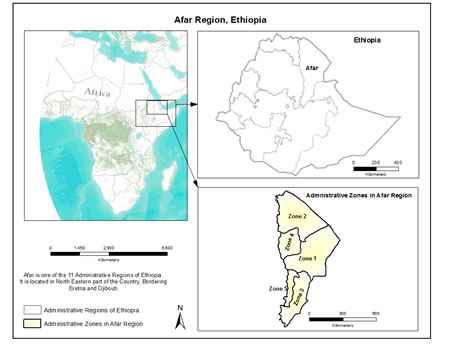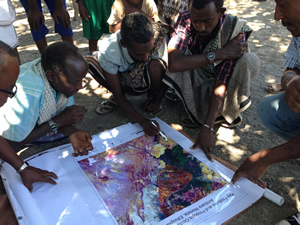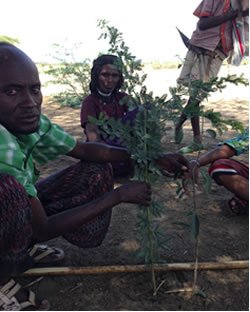September 9, 2014
By Matt Luizza and Tewodros Wakie
 During the month of April, we had the unique opportunity to work with seven villages across the Afar region of Ethiopia. This area is one of the hottest habitable places on the planet. Temperatures in Afar surpass 122°F and the region receives less than 200mm of annual rainfall. Around 80% of the population are pastoralists, and herd predominately cattle, goats, sheep and camels. Local communities have adapted to cope with the vulnerabilities associated with such a harsh, arid environment, but drought, collapse of livestock markets, and the influx of invasive plants are preeminent shocks to which they are continually at risk. With invasive species having an array of detrimental impacts on ecosystems and rural livelihoods in arid and semi-arid regions around the world, we hoped to learn from local Afar pastoralists about the changes they are witnessing on the landscape and assist in mapping the threat posed by different invasive plants to local livelihoods.
During the month of April, we had the unique opportunity to work with seven villages across the Afar region of Ethiopia. This area is one of the hottest habitable places on the planet. Temperatures in Afar surpass 122°F and the region receives less than 200mm of annual rainfall. Around 80% of the population are pastoralists, and herd predominately cattle, goats, sheep and camels. Local communities have adapted to cope with the vulnerabilities associated with such a harsh, arid environment, but drought, collapse of livestock markets, and the influx of invasive plants are preeminent shocks to which they are continually at risk. With invasive species having an array of detrimental impacts on ecosystems and rural livelihoods in arid and semi-arid regions around the world, we hoped to learn from local Afar pastoralists about the changes they are witnessing on the landscape and assist in mapping the threat posed by different invasive plants to local livelihoods.
Over the period of a week, 39 men and 7 women participated in our focus groups and participatory mapping activities. At each site pastoralists were interviewed about changes they are witnessing on the landscape and impacts of invasive species on local livelihoods. Additionally, participatory mapping activities were conducted. High-resolution satellite imagery of the region were overlaid with clear acetate paper, and participants were given markers to draw the locations of invasive species on the map. Across all of the villages, participants noted combined pressures of extensive drought, reduced water flow from the Awash River due to large-scale government farms, and the influx of invasive species. Participants astutely noted the connections between all three issues, with drought facilitating the establishment of invasive plants, and large scale agriculture development disturbing the land and providing novel habitat for these invaders through extensive irrigation ditches. “The pastoralist way of life is changing”, one man noted. Changes to plants, water, soils and wildlife are occurring, with populations of native flora and fauna declining as a result of these combined crises. “When native species were plentiful, we used to have cold air and plenty of water. Now it is the opposite. Invasive plants, hot air and little water.” Pastoralists across all villages relayed the acute changes occurring to all four major rainy seasons. All rainy seasons are experiencing noticeable reductions in the amount and predictability of rain which is believed to be helping spread invasive plants. “Kerma”, which is the primary rainy season that historically spanned four months from June through September, is now limited to the month of August. “Detrob”, which in the recent past spanned October and November, now only occurs over a maximum span of five days. “Dedaɑ” which historically occurred in January and February, and “Segum” which occurred in April have disappeared entirely. Another pastoralist further added that “dedaɑ” and “detrob” had already passed this year with no rain, somberly adding “what is left is only the names of the seasons”.
Participants astutely noted the connections between all three issues, with drought facilitating the establishment of invasive plants, and large scale agriculture development disturbing the land and providing novel habitat for these invaders through extensive irrigation ditches. “The pastoralist way of life is changing”, one man noted. Changes to plants, water, soils and wildlife are occurring, with populations of native flora and fauna declining as a result of these combined crises. “When native species were plentiful, we used to have cold air and plenty of water. Now it is the opposite. Invasive plants, hot air and little water.” Pastoralists across all villages relayed the acute changes occurring to all four major rainy seasons. All rainy seasons are experiencing noticeable reductions in the amount and predictability of rain which is believed to be helping spread invasive plants. “Kerma”, which is the primary rainy season that historically spanned four months from June through September, is now limited to the month of August. “Detrob”, which in the recent past spanned October and November, now only occurs over a maximum span of five days. “Dedaɑ” which historically occurred in January and February, and “Segum” which occurred in April have disappeared entirely. Another pastoralist further added that “dedaɑ” and “detrob” had already passed this year with no rain, somberly adding “what is left is only the names of the seasons”.
Three invasive plants were described throughout the villages, including the thorny mesquite tree “woyane hara” (Prosopis juliflora), which is considered the worst, taking over rangelands, reducing water access, making livestock movement difficult, and providing cover for predators including lions and hyenas. One of P. juliflora's most damaging impacts is the reduction in forage for livestock, with pastoralists noting the need to travel over 10km to access grass, leading to conflict with Somali clans and resulting in cattle theft and killings. As one pastoralist noted “wherever there is woyane, there is no grass”. A sentiment supported by the nods and grunts of other community members sitting nearby. “Wola howla” (Parthenium hysterophorus) is a national invader that is not prevalent in Afar yet but is starting to encroach on farmlands and rangelands, producing pollen that causes acute allergies and sinus problems and if eaten by camels, makes their milk bitter. “Halemero” (Cryptostegia grandiflora), is the newest invader to the region. Commonly known as rubber vine, this plant is poisonous to livestock, and kills native trees by growing up into their canopy and choking out their access to sunlight. As one pastoralist bluntly stated, “where halemero grows, nothing else will”. Villages where C. grandiflora densities are low did not view the vine as a major threat, yet P. juliflora which is considered one of the highest priority invasive species in Ethiopia, was once viewed with similar ambivalence. Limited work has been done assessing the newly established C. grandiflora, but its rapid expansion warrants attention. The vine was noted to kill native trees around the Awash River that are extremely important to pastoral livelihoods. We catalogued eight native tree species threatened by C. grandiflora, that are critical sources of fuelwood for pastoralists, but also provide an array of other services. The three most important fuelwood species alone, locally called “kasalto” (Acacia nilotica), “adado” (Acacia senegalis) and “kilaito” (Combretum aculeatum), collectively provide nine distinct services including charcoal, construction, cosmetic, firewood, food, livestock fodder and forage, wildlife forage, medicinal, and shade uses.
A sentiment supported by the nods and grunts of other community members sitting nearby. “Wola howla” (Parthenium hysterophorus) is a national invader that is not prevalent in Afar yet but is starting to encroach on farmlands and rangelands, producing pollen that causes acute allergies and sinus problems and if eaten by camels, makes their milk bitter. “Halemero” (Cryptostegia grandiflora), is the newest invader to the region. Commonly known as rubber vine, this plant is poisonous to livestock, and kills native trees by growing up into their canopy and choking out their access to sunlight. As one pastoralist bluntly stated, “where halemero grows, nothing else will”. Villages where C. grandiflora densities are low did not view the vine as a major threat, yet P. juliflora which is considered one of the highest priority invasive species in Ethiopia, was once viewed with similar ambivalence. Limited work has been done assessing the newly established C. grandiflora, but its rapid expansion warrants attention. The vine was noted to kill native trees around the Awash River that are extremely important to pastoral livelihoods. We catalogued eight native tree species threatened by C. grandiflora, that are critical sources of fuelwood for pastoralists, but also provide an array of other services. The three most important fuelwood species alone, locally called “kasalto” (Acacia nilotica), “adado” (Acacia senegalis) and “kilaito” (Combretum aculeatum), collectively provide nine distinct services including charcoal, construction, cosmetic, firewood, food, livestock fodder and forage, wildlife forage, medicinal, and shade uses.
Participants showed us locations of the different invasive species and GPS points were taken of each, to be used in conjunction with the participatory mapping data to help model the suitable habitat of invaders across the region. Successful control of invasive species depends on early detection and rapid response, which is often best achieved through meaningful collaboration with local communities that live on the affected landscapes. We will be back in Afar later this year to share preliminary risk assessment maps to the same villages and continue to engage in shared learning between Colorado State University and the pastoral villages, to help address this pressing issue.
Matt Luizza is PhD student in the Graduate Degree Program in Ecology (GDPE) and USDA NIFA Fellow through the Natural Resource Ecology Laboratory. He is co-advised by Paul Evangelista (NREL) and Michele Betsill (Department of Political Science).
Tewodros Wakie is also PhD student in the Graduate Degree Program in Ecology (GDPE) and USDA NIFA Fellow through the Natural Resource Ecology Laboratory. He is co-advised by Melinda Laituri (ESS) and Paul Evangelista (NREL).